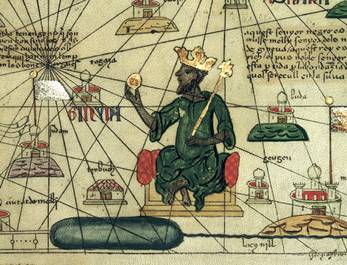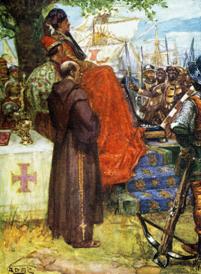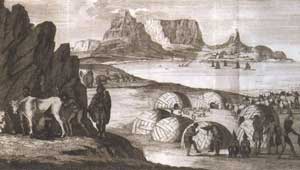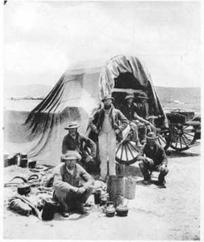Portuguese trading stations in West Africa and the slave trade
Portuguese expansion into Africa began with the desire of King John I to gain access to the gold-producing areas of West Africa. The trans-Saharan trade routes between Songhay and the North African traders provided Europe with gold coins used to trade spices, silks and other luxuries from India. At the time there was a shortage of gold and rumours were spreading that there were states in the south of Africa which had gold. This news encouraged King John’s son, Prince Henry, to send out expeditions to explore these possibilities.
At first, the Portuguese established trading stations along the west coast of Africa rather than permanent settlements. They built forts at Cape Blanco, Sierra Leone and Elmina to protect their trading stations from rival European traders. In this way, the Portuguese diverted the trade in gold and slaves away from the trans-Saharan routes causing their decline and increased their own status as a powerful trading nation.
During the 1480s the Portuguese came into contact with the kingdom of the Kongo, situated south of the Congo river in what is today northern Angola. The Kongo became powerful through war and capturing and enslaving the people they defeated.
The Portuguese did not conquer this region but chose rather to become allies of the Kongo king. The king was eager to make use of Portuguese teachers and craftsmen to train his people. He also allowed Catholic missionaries to work among his people. The Portuguese traded guns for slaves captured by the Kongo in wars against rival kingdoms in the interior. Other than small amounts of copper and raffia cloth, the area did not provide any profitable trade in gold or silver, which was disappointing for the Portuguese. The traffic in slaves more than made up for this disappointment.
In the 1490s sugar plantations were established on the islands of São Tomé and Principé. The Portuguese settlers on these islands used slaves bought from the Kongo traders to work on these plantations. Very soon São Tomé became the largest producer of sugar for Europe. When Brazil became a Portuguese colony in the 1530s, the demand for slaves to work on the sugar plantations established there increased. São Tomé became an important holding station for slaves before they left on the trans-Atlantic voyage to South America.
As the demand for slaves increased in Brazil, the São Tomé traders found a better supply of slaves further south near Luanda and Benguela. Wars fought in this region provided a constant supply of slaves. In exchange for slaves, the Portuguese provided the Ndongo and Lunda kings with guns, cloth and other European luxuries. The guns enabled the kings to defeat their enemies and maintain a dominant position in the region.
In 1641, the Dutch seized the slave trade in Angola away from the Portuguese and they were able to control it until 1648 when the Portuguese took back control again. Angola only became a Portuguese colonial settlement after the decline of the slave trade in the nineteenth century.
Consequences on the indigenous society
- The Portuguese introduced agricultural products grown in South America such as maize, sugar cane and tobacco. Coffee plantations were introduced to Angola in the nineteenth century. Coffee is one of Angola’s major exports today.
- The Portuguese introduced guns to the region which changed the nature of warfare and enabled their allies to dominate other kingdoms.
- The Portuguese encouraged wars between rival kingdoms to maintain a constant supply of slaves. The result of this was that the region was constantly at war and millions of young people, mainly men, were forced to leave Africa and work as slaves in the Americas.
- The Portuguese language is mainly spoken in urban areas of Angola today. However, the indigenous languages have survived among the rural population.
- In modern Angola, about ninety per cent of the population is Christian, mainly Catholic, as a result of Portuguese missionary activity in the area. The remainder of the population follows traditional African religions.
Portuguese trading stations in East Africa and the Slave trade
 A map drawn in Spain dated 1375, showing the king of Mali holding a gold nugget. Source: British Library
A map drawn in Spain dated 1375, showing the king of Mali holding a gold nugget. Source: British Library
Well-established gold and ivory trade network existed between African kingdoms in the interior and cities on the east coast of Africa. For centuries Arabs had traded with African kingdoms such as Great Zimbabwe and Mwanamutapa in order to supply Arabia, the Persian Gulf, India and even China with African ivory and gold. The Arab settlers intermarried with the indigenous African people living along the east coast. They introduced Islam and influenced the development of the Swahili language. A new coastal society emerged that was a mixture of African and Islamic traditions. This prosperous society built beautiful cities along the coastline from where they conducted trade with Arab merchants. The most important of these cities were Zanzibar, Kilwa, Mombasa, Mozambique Island and Sofala.
In the sixteenth century the Portuguese drove the Arabs away from the east coast of Africa and established their own trade monopoly in the region. They arrived with heavily-armed ships and demanded that the Muslim sultans (or rulers) accept the authority of the king of Portugal by paying a large tribute. If they refused to do this, the cities were looted and destroyed. The Portuguese regarded this as a continuation of the ‘holy Christian war’ they had been fighting against the Muslims in Europe for centuries.
Zanzibar was the first of these cities to be attacked in 1503. The city was bombarded with canon fire from the ships of Portuguese captain, Ruy Lourenço Ravasco. In 1505, Francisco d’Almeida arrived with eleven heavily-armed ships that destroyed Kilwa, Mombasa and Barawa. To strengthen their position along the coast the Portuguese erected massive stone fortresses in Kilwa, Sofala, Mozambique Island and Mombasa. These fortresses enabled them to control the trade in the western Indian Ocean as well as the trade with the African kingdoms in the interior.
From Sofala they conducted trade in ivory, gold and slaves with the Mwanamutapa kingdom. Trading stations were also established at Quilimane north of Sofala, and at Sena and Tete along the Zambezi River. Further south Lourenco Marques was sent to Delagoa Bay to establish trade with the indigenous people living there.
The Portuguese control of the Indian Ocean trade
The Portuguese did not have an easy time on the east coast of Africa. They found the climate inhospitable and many died of tropical diseases. They were also constantly attacked by hostile inhabitants of the area and were unable to conquer the interior of Africa. They managed to keep control by making alliances with warring clans and promising to help them against their enemies.
The Portuguese rulers believed it was their duty to spread the Catholic religion. Missionary activity began in 1560. Both the Jesuits and Dominicans were active in converting Africans to Catholicism. They even managed to convert one of the heirs to the Mwanamutapa dynasty who gave up his right to be king and joined a convent in Santa Barbara in India.
By the early sixteenth century the Portuguese had established a string of bases in Asia, including Hormuz at the tip of the Persian Gulf; Goa on the west coast of India and the Straits of Molucca in the East Indies.
From these bases, the Portuguese could control the sea-going trade of the entire western Indian Ocean. However, Portugal was mainly a maritime power; it was not able to defeat other military powers. When larger European nations like the Dutch, English and French arrived in the area, Portuguese power and control ended, and by 1650 they only had control in ports such as Delagoa Bay, Mozambique Island and Mombasa. Mozambique (Portuguese East Africa) was only recognised as a Portuguese colony by the other European powers in 1885.
 During the fifteenth and sixteenth centuries, Portugal led the world in navigation and exploration, and they believed it was their duty to spread the Catholic religion. Portuguese missionaries receiving the ‘native chief’ at Elmira. Source: www.heritage-history.com
During the fifteenth and sixteenth centuries, Portugal led the world in navigation and exploration, and they believed it was their duty to spread the Catholic religion. Portuguese missionaries receiving the ‘native chief’ at Elmira. Source: www.heritage-history.com
Consequences on the indigenous society
- The Portuguese destroyed the Arab trade routes in the Indian Ocean between Africa, Arabia and India.
- The Portuguese replaced Arab control of the trade in ivory, gold and slaves with their own.
- They traded up the Zambezi river and interfered with the existing inland African trade. Only kingdoms that co-operated with the Portuguese benefited from this interference.
- Portuguese is still spoken in Mozambique, but the majority of the rural population speaks one of the indigenous Bantu languages.
- Only thirty per cent of the population is Christian, mostly Catholic. The majority of the population practise traditional African religions or no religion at all.
The Process of Dutch Colonisation and Dutch East India Company
The Dutch challenged Portuguese domination of the Indian Ocean trade in the late sixteenth century when they began trading in spices, calico and silks in the East and gold, copper, ivory and slaves in Africa. In the seventeenth and early eighteenth centuries the Netherlands became the wealthiest European trading nation, until Britain challenged them in the eighteenth and nineteenth centuries.
The Dutch East India Company (known by the Dutch abbreviation VOC) was established in 1602 to conduct Dutch trade with the East Indies. Its headquarters were in Jakarta on the island of Java. Because the journey to the East took so long, European shipping nations stopped at the Cape of Good Hope to collect fresh water and food. The Khoikhoi people at the Cape traded sheep, cattle, ivory, ostrich feathers and shells for beads, metal objects, tobacco and alcohol. Unlike the Portuguese, the Dutch did not trade guns as they did not want the Khoikhoi to use the guns against them.
In 1652, the VOC decided to establish a permanent refreshment station at the Cape. Jan van Riebeeck was appointed commander of this station. It was his responsibility to build a fort for their protection and a hospital for sick sailors. Employees of the company planted vegetables and obtained meat from the Khoikhoi so that they could supply the ships as they called in at Table Bay. French and English ships were also allowed to stop at the Cape, but they were charged very high prices.
 The foreground of this illustration from Bogaarts's Historische Reizen (1711) depicts the Khoikhoi way of life. The background shows the Dutch settlement and way of life beginning to take root. Source: South African National Library
The foreground of this illustration from Bogaarts's Historische Reizen (1711) depicts the Khoikhoi way of life. The background shows the Dutch settlement and way of life beginning to take root. Source: South African National Library
Expansion of the Dutch settlement
Increasingly the Khoikhoi lost land and cattle to the Dutch as the settlement grew. This brought the Dutch into conflict with the powerful Cochoqua chief, Gonnema, who refused to trade with the VOC. The Company used rival Khoikhoi clans to raid the Cochoqua herds between 1673 and 1677. This is known as the Second Khoikhoi-Dutch War. The Cochoqua were defeated and lost all their cattle and sheep to the Dutch and their Khoikhoi allies. The boers then settled on their land.
Wheat and grapes for wine were grown in this area for the settlement and for export to the passing ships. The settlers were sold slaves from Madagascar, Mozambique and Indonesia to work the land.
The Trekboers
As the settlement grew, some of the farmers became hunters and cattle farmers in the interior of the Cape. They were known as ‘trekboers’ because they lived in ox-wagons and were always on the move. They were granted large pieces of land each and allowed their cattle to graze on the land until it was overgrazed and then they would move on.
In the 1680s and 1690s the VOC encouraged Dutch and French Huguenot immigration to the Cape. The new arrivals were settled in the fertile valleys of Paarl, Stellenbosch and Franschhoek. Wheat and grapes for wine were grown in this area for the settlement and for export to the passing ships. The settlers were sold slaves from Madagascar, Mozambique and Indonesia to work the land.
 Trek Boers in the Karoo. Source: wikipedia
Trek Boers in the Karoo. Source: wikipedia
Khoikhoi resistance in the interior
The Khoikhoi were at a disadvantage in their struggle to resist the expansion of the Dutch settlement at the Cape. They had no guns or horses and were nearly wiped out by a series of smallpox epidemics that swept through the Cape starting in 1713. Like the Aztecs in Mexico, they had no immunity against European diseases and they died in their thousands.
The Khoikhoi found different ways to resist Dutch expansion. At first they resisted by attacking and raiding Dutch farms. In reaction, the trekboers formed themselves into military groups called ‘commandos’ and attacked the Khoikhoi in order to get back their cattle. As a result, hundreds of Khoikhoi people were killed. As soon as the commandos returned to their farms, the Khoikhoi attacked again, setting in motion a continuous cycle of attack and counter-attack.
In the end the Khoikhoi had two options. Either they could move into more remote and drier regions of the expanding colony or else they could become servants of the boers acting as trackers, herdsmen and shepherds. Some even joined boer commandos and attacked other Khoikhoi groups. The boers were not allowed to enslave the indigenous people of South Africa, so these Khoikhoi servants remained free citizens, but they were seldom paid wages. They were usually paid in food, clothing, housing, brandy and tobacco. They were sometimes allowed to keep cattle, but they lost their independence and with that much of their culture and language. In the Eastern Cape, many Khoikhoi people were absorbed into Xhosa society.
Consequences on the indigenous society at the Cape
- The arrival of Dutch settlers marked the permanent settlement of Europeans in Southern Africa.
- Dutch laws, customs and attitudes towards race were brought to South Africa and Dutch people became the ruling class until the Cape was taken over by the British in 1806.
- The Dutch did not actively encourage the Khoikhoi or slaves to become Christians as this would imply they were equal.
- The process of land dispossession by indigenous people in South Africa began soon after the arrival of the Dutch and lasted until 1994.
- Racial mixing occurred at the Cape, but it was never openly accepted like it was in colonies such as Brazil and Mexico. A few legal marriages did occur between different races, but most of the relationships across race lines were between European men and their female slaves or Khoikhoi servants. The children of these relationships formed part of what is known today as the Cape Coloured community.
- Freed slaves were also included into the Cape Coloured community. Many of the freed slaves were Muslims and maintained their Malay cultural and religious traditions.
- The Dutch language became simplified as it was spoken by the multi-cultural community that existed at the Cape. Portuguese, Malay and Khoikhoi words were included in the common language now spoken, which became known as ‘Afrikaans’.
Slavery and its impact in the Cape
Slavery affected the economy of the Cape, as well as the lives of almost everyone living there. Its influence also lasted long after the abolition of slavery in 1838.
In South Africa under Dutch settlement, there was a shortage of labour, especially on the wheat and wine farms. But the VOC did not want to spend its money on the expensive wages that European labourers demanded. Nor could the VOC use the Khoi people as slaves. The Khoi traded with the Dutch, providing cattle for fresh meat. The Khoi also resisted any attempts to make them change their pastoralist way of life.
The Dutch were already involved in the Atlantic slave trade and had experience in buying and controlling slaves. They thus imported slaves as the cheapest labour option. Slaves were imported from a variety of places, including the east coast of Africa (Mozambique and Madagascar), but the majority came from East Africa and Asia, especially the Indonesian Islands, which were controlled by the Dutch at the time. This explains, for instance, why there is a relatively large number of people of Malaysian descent in the Cape (the so-called Cape Malays).
Initially, all slaves were owned by the VOC, but later farmers themselves could own slaves too. Slaves were used in every sector of the economy. Some of the functions of the slaves included working in the warehouses, workshops and stores of the VOC, as well as in the hospital, in administration, and on farms or as domestic servants in private homes. Some slaves were craftsmen, bringing skills from their home countries to the Cape, while others were fishermen, hawkers and even auxiliary police. The economy of the Cape depended heavily on slave labour.
The lives of the slaves were harsh, as they worked very long hours under poor conditions. They were often not given enough healthy food and lived in overcrowded and dirty conditions. Slaves had no freedom at all ”” they were locked up at night, and had to have a pass to leave their place of employment. As they were regarded as possessions, they were unable to marry, and if they had children, the children belonged to the slave’s owner and were also slaves. They also had little chance of education. Women slaves were at risk of being raped by their masters and other slaves.
A traveller, Otto Mentzel, observed that:
"It is not an easy matter to keep the slaves under proper order and control. The condition of slavery has soured their tempers. Most slaves are a sulky, savage and disagreeable crowd ”¦ It would be dangerous to give them the slightest latitude; a tight hold must always be kept on the reins; the taskmaster’s lash is the main stimulus for getting any work out of them." - Source: Mentzel, A Geographical and Topographical Description of the Cape of Good Hope, Cape Town, 1921
While there were many laws inhibiting the lives and movements of slaves, there were also rules to protect them, for example, female slaves could not be beaten. In theory, slave owners would be punished for treating their slaves badly ”” for example, if they went so far as to beat them to death ”” but the laws were often ignored.
 Slave ‘sale’ in Africa in 1829 is advertised on the same poster as the sale of rice, books, muslins etc. Source: www.chrislayson.com
Slave ‘sale’ in Africa in 1829 is advertised on the same poster as the sale of rice, books, muslins etc. Source: www.chrislayson.com
The abolition of slavery in South Africa
The Abolition of Slavery Act ended slavery in the Cape officially in 1834. The more than
35 000 slaves that had been imported into South Africa from India, Ceylon, Malaysia and elsewhere were officially freed, although they were still bonded to their old masters for four years through a feudal system of "apprenticeship". For many years wages rose only slightly above the former cost of slave subsistence.
The abolition of slavery and the emancipation of slaves caused a lot of resentment and opposition from the Cape colonials towards the anti-slavery lobby, as embodied in the
London Missionary Society that had put pressure on the British government to take this decision. Even before emancipation, the publicised cases of missionary intervention on behalf of mistreated black workers on farms, sometimes even winning convictions against farmers, made them enemies of the largely Afrikaner farming community in the Cape. Reverends John
Philip, Johannes van der Kemp and John Read were the most hated missionaries because of their fight for the rights of oppressed black Cape residents.
In fact, one of the reasons for the Great Trek, which would lead to the migration of many white, Dutch-speaking farmers away from the Cape after 1833, was the abolition of slavery by the British government. The farmers complained that they could not replace the labour of their slaves without losing a great deal of money. Importantly, the abolition of slavery did not change the colonial–feudal "slave–master" relations between black and white. Instead, these slave–master relations imprinted themselves on South Africa’s political, social and economic structures for years to come. Black people were "enslaved" by the oppressive laws of industrialisation, pass regulations, and labour ordinances such as the Masters and Servants Act of 1841, which made it a criminal offence for a worker to break a labour contract. It was only after 1994, and the dawning of democracy in South Africa, that all South Africans were truly emancipated from slavery.
Example of slave-master relations that continued after the ‘abolition of slavery’: Indentured Labourers.
In Natal following the successful introduction of sugar cane farming in 1855, farmers asked the government to introduce indentured Indian labourers to work on plantations. Indian people were identified as suitable for the work because the British and French had success using them in sugar plantations in Mauritius and Madagascar. Natal was still a British Colony at the time and an office called the Protector of Immigrants was set up, it was a transformation of the Slave Protector’s office that existed during years of slavery in the Cape. The functions of the Slave Protector were similar those of the office created to protect indentured labourers. The people coming from India, over whom this contract was established, were not consulted and provisions were not made to ensure their full understanding of the laws and conditions of employment. Instead, they were requested to swear an oath of allegiance to their unknown future employer. Once in Natal they were divided among sugar planters like slaves in an auction. E S Reddy , a well-known Indian scholar has compared indentured labour with slavery.
Consequences on the World
The expansion of European trade resulted in the colonisation of five continents over a period of five centuries. Using military force, each of the European colonial powers dominated world trade at different times. When one colonial power became weak, another challenged it and replaced it as the dominant power.
What was the effect of colonialism on the World
- Colonial empires became rich and powerful as their empires grew in size. However, colonies were expensive to run, especially if wars were involved. Wars were fought between rival empires who wanted the same land or to defeat rebellious indigenous inhabitants.
- Europe, in particular Britain, was able to industrialise because of raw materials obtained from colonies and because colonies provided markets for manufactured goods. Slavery did not start because of colonialism; slavery has always existed. However, European powers were able to exploit their colonies and increase their wealth by using slave labour or very cheap indigenous labour.
- Colonialism did not cause racism, but it helped to reinforce the belief that Europeans were the dominant race and therefore superior and those other races were subordinate and therefore inferior.
- On the other hand, colonialism provided opportunities for people of different races, religions and cultures to meet live and work together. The result of this has been an exchange of ideas, technology and traditions.
- The spread of Christianity throughout the world was made possible by missionary activities. This was assisted by the expansion of European colonial empires.
- Church and state worked together to change the indigenous belief systems of the people they ruled. Colonial expansion also brought Christianity into conflict with Islam as European powers challenged Muslim rulers and traders.